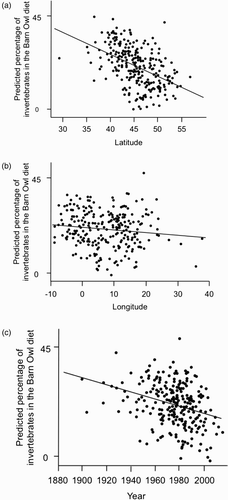Abstract
Capsule The analysis of 616 papers about the diet of the European Barn Owl Tyto alba showed that 9678 invertebrates were captured out of 3.13 million prey items (0.31%). The consumption of invertebrates strongly decreased between 1860 and 2012. This further demonstrates that the Barn Owl diet changed to a large extent during the last 150 years.
The barn owl is particularly suited to investigate the diet of a predator. Its pellets contain the remains of their prey, which are exceptionally well preserved compared to pellets of other raptors and owls. Because of this property, many researchers have performed detailed studies on the Barn Owl diet throughout Europe during the last 150 years. By reviewing this literature, it could be shown that the barn owl diet changed significantly from 1860 to these days. In particular, there was a significant decrease in the consumption of bats (Roulin & Christe Citation2013) and birds (Roulin Citation2015). One can therefore predict a strong decline in the consumption of invertebrates because of the use of insecticides and habitat loss. In the present paper, I report an analysis about invertebrate consumption by the European barn owl. To this end, I reviewed the barn owl literature by considering all papers published in international and local journals (see Roulin & Dubey Citation2012).
Of 616 studies, invertebrates appeared to be rarely consumed by Barn Owls with the median percentage being 0 and mean 0.89% per study; in total 9678 invertebrates were consumed out of 3,128,370 identified prey items, 0.31% (Table S1). The highest percentage of invertebrates was 45.4% in a sample of 141 identified prey items in Italy (Contoli et al. Citation1988). Among identified invertebrates, 7726 were insects (99.34%), 25 spiders and scorpions (Arachnids), 11 snails and slugs (Gastropods), 7 annelid worms (Citellata), 5 scolopendra (Chilopoda), 2 crustaceans (Malacostraca) and 1 mollusc (Bivalvia). Among insects, Barn Owls consumed as often Orthoptera (3723, 48.19%) as Coleoptera (3721, 48.16%). Other families were less often consumed with 101 Dermaptera, 43 Mantodea, 43 Hemiptera, 32 Hymenoptera, 25 Diptera, 22 Lepidoptera, 8 Neuroptera, 4 Odonata and 4 Blattodea. The most frequently captured genuses are Gryllotalpa (967 individuals), 829 Gryllus, 488 Copris, 380 Melolontha and 162 Geotrupes. Of note is the absence of any cicadas (Cicadidae) suggesting that Barn Owls capture most often insects that sing loudly at night and species that are abundant and easily detectable (Table S2).
Three hundred and seventy-two studies did not report any invertebrate in the Barn Owl diet and 244 at least one. The probability that at least one invertebrate was found in the diet decreased with latitude (logistic regression: χ2 = 78.76, P < 0.0001) and declined along the years (χ2 = 6.25, P = 0.012) after controlling for log-transformed total number of prey items identified (χ2 = 34.15, P < 0.0001). In contrast, the variable ‘island' (97 studies were done on islands and 519 on mainland), longitude alone and in interaction with year as well as the interaction between latitude and year were not significant (P-values > 0.15).
I then considered the 244 studies reporting at least one invertebrate. The log-transformed percentage of invertebrates found in the diet decreased with latitude (F1,236 = 70.89, P < 0.0001), slightly decreased with longitude (F1,236 = 3.91, P = 0.049) and strongly declined along the years (F1,236 = 26.16, P < 0.0001) after controlling for log-transformed total number of prey items identified (F1,236 = 129.75, P < 0.0001) (). In contrast, the terms ‘island' and the interactions between year and longitude and between year and latitude were not significant (P-values > 0.10).
Figure 1. Percentage of invertebrates in Barn Owl diet in Europe in relation to latitude (a), longitude (b) and year (c). Predicted lines from an overall model (see text) are plotted.

The present study further demonstrates that the diet of a predator changed to a large extent during the last 150 years probably due to the negative impact of human activities on biodiversity. As shown in previous papers, bats (Roulin & Christe Citation2013) and birds (Roulin Citation2015) are less often captured nowadays than in the past. The temporal decline in invertebrate consumption appears to be particularly strong potentially suggesting that the decrease in bat and bird consumption might be driven by the strong decline in invertebrates possibly due to the use of insecticides and other human-related changes in habitat and climate. Engineers call the discovery of insecticides the ‘golden age of insecticide research' (Casida & Quistad Citation1998) although a cynic might suggest that it appears that we are currently living the ‘golden age of biodiversity destruction' because of the use of insecticides. Insects are rich in proteins and unsaturated fat as well as carotenoids, and hence a diet with fewer insects may affect the health of their predators.
Supplemental data
Supplemental data Table S1 (the different species recorded as consumed by Barn Owl studies in Europe) of this article can be accessed at 10.1080/00063657.2015.1125440 .
Supplementary material
Download Zip (134.7 KB)ACKNOWLEDGEMENTS
I am grateful to the Swiss Ornithological Institute for opening their library to me.
References
- Casida, J.E. & Quistad, G.B. 1998. Golden age of insecticide research: past, present, or future? Annu. Rev. Entomol. 43: 1–16. doi: 10.1146/annurev.ento.43.1.1
- Contoli, L., Aloise, G. & Grazia Filippucci, M. 1988. Sulla diversificazione trofica di barbagianni Tyto alba e civetta Athene noctua in rapporto al livello diagnostico delle prede. Avocetta 12: 21–30.
- Roulin, A. 2015. Spatial variation in the decline of European birds as shown by the barn owl (Tyto alba) diet. Bird Study 62: 271–275. doi: 10.1080/00063657.2015.1012043
- Roulin, A. & Christe, P. 2013. Geographic and temporal variation in the consumption of bats by European barn owls. Bird Study 60: 561–569. doi: 10.1080/00063657.2013.847051
- Roulin, A. & Dubey, S. 2012. The occurrence of reptiles in barn owl diet in Europe. Bird Study 59: 504–508. doi: 10.1080/00063657.2012.731035
